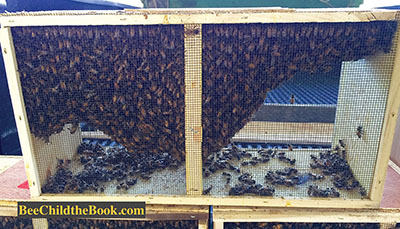
For my thermal photography work, I had mostly concentrated on top-bar hives. Now I wanted to extend this new way of seeing to frame hives. For this work, I used five packages. I faced most all the current difficulties with packages, beginning with the expense, $729 including shipping. Three new colonies had queen problems, resulting in big setbacks. The erratic spring weather dealt cruel cards too, in terms of cold days when new colonies needed to grow. Yet from my long-time veteran experience with package colonies, I built them into strong colonies occupying a brood chamber (deep super) and two or three medium supers (eight frame hives).
The end-of-season hive weights of the package colonies were, in pounds, 90, 98, 143, 152, 183, (in kilograms, 40.8, 44.5, 64.9, 68.9, 83.0). While that result is impressive, it took a commitment to my bees. Let’s begin.
Good shipping dates were still available when I ordered the bees. I picked the first week of April for an arrival date, which is a good time for Richmond, Virginia. I have picked that week for package bees since the 1960’s when I began beekeeping. Back then, my family lived a couple of blocks from a large postal mail sorting facility. For packages, more so for queens in the summer, I went to the post office everyday beginning just after the shipping day to ask about my bees.
Of course all the postal clerks knew me. Once early in the morning, long before the regular mail delivery, the mail jeep stopped in front of our house with a package of bees. For a ten-year-old kid, that was a big deal, decades before tracking numbers.
The past couple of times I ordered packages, poor spring weather delayed shipment for about two weeks. Locally I know of new beekeepers receiving packages even in late May. With the spring nectar flow ending usually by the second week of June, the build-up time for a new colony is extremely brief. That means the new beekeeper needs to feed the colony sugar syrup and a pollen substitute, not only to get its combs built, but also to provide the bees winter stores. In locations where a dearth prevails in summer coupled with a weak fall flow, this feeding commitment could be substantial. While I do not recommend this strategy to beginners, I have even picked a shipping date in the latter part of March, probably when the weather would not be good for starting a colony at my location. Of course, I am counting on a shipping delay so the bees actually arrive in early April when I really want them.
Given the cold, late, and wet weather of this past spring (2018), the packages were delayed two weeks, which was understandable. From Virginia, I watched the weather in the southeast, the location of the bee producer. I expected the two late notifications sent by emails. After all, for the bee producer, their colonies needed time to build up and, most critically, their queens required good weather to mate.
The five packages arrived on Friday, April 20 , 2018. I knew the arrival day from the tracking number provided by the bee producer. However in the postal stream, a critical scan was missed so I did not know the bees passed through a sorting center in Virginia. Usually I meet the bees at the post office, but a postal clerk had to call me. Always leave your contact information at the arrival post office. Pick up the bees before they go “out for delivery,” where the packages would ride around, stopping at numerous addresses. I have found over the years, the postal personnel are very happy to give up the bees.
The package bees arrived in good condition. Always check for dead/lost bees possibly resulting from leaking feeder cans, or punctures in the screen of the cages, or unknown causes–before signing for the bees. If possible, take a smart phone with you and photograph any damage from different viewpoints. The bee producer will want to see the photographs as evidence of damage. If more than one package is damaged, make sure your pictures clearly indicate each particular package. Photograph each package on/by a different piece of paper, like an advertising mail flyer. Follow the bee producer’s rules and shipper’s rules for filing a claim. Roughly a handful of dead bees on the cage floor is acceptable (see Figure 1).
The morning was chilly when I picked up the bees. They could have ridden in the back of the pickup truck, enduring the wind turning cold, blowing hard while I drove along the highway. I could not do that to my bees. We all squeezed in the cab (see Figure 2).
This kind of mothering of my packages reminds me of a far more extensive “bee package run.” I was still living at home with my parents in Richmond, Virginia. To expand my operation (in ten-frame hives), I purchased 50 three-pound packages, which were cheaper in those days. There was no shipping. I drove my first fairly-decrepit bee truck to Georgia to pick up the packages, at the time roughly a 10-hour drive, and I waited a few hours for the bees. I was supposed to spend the….


